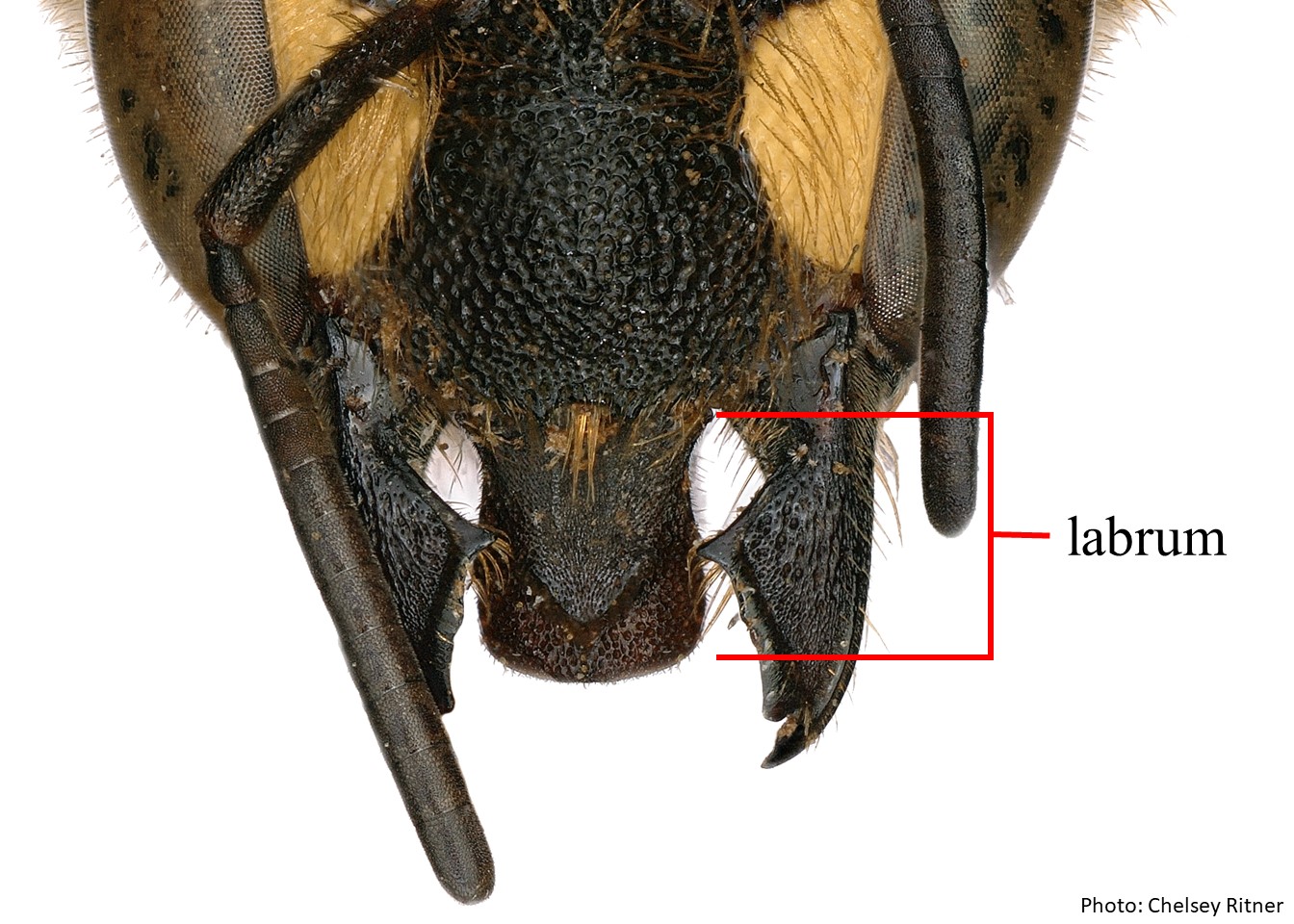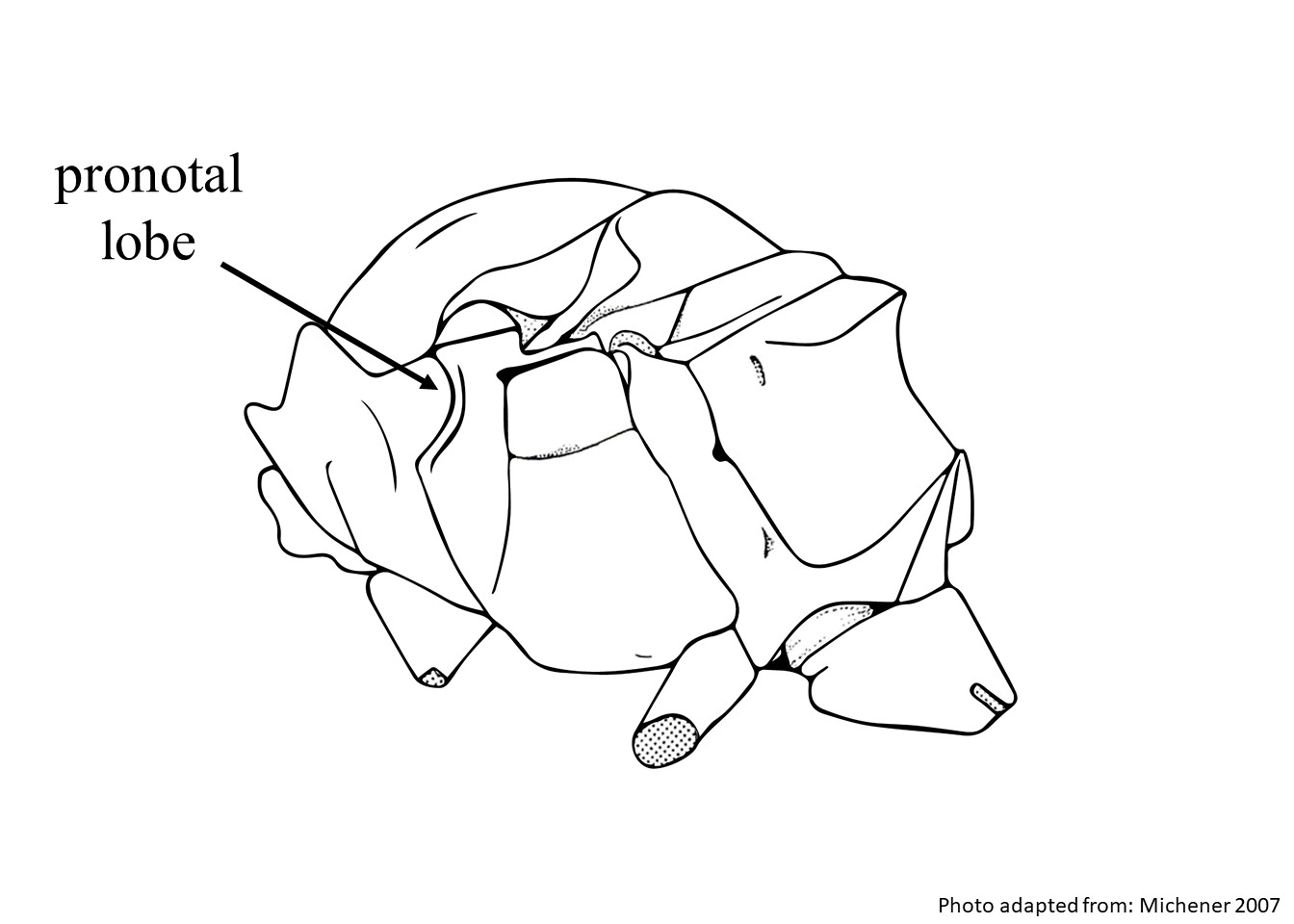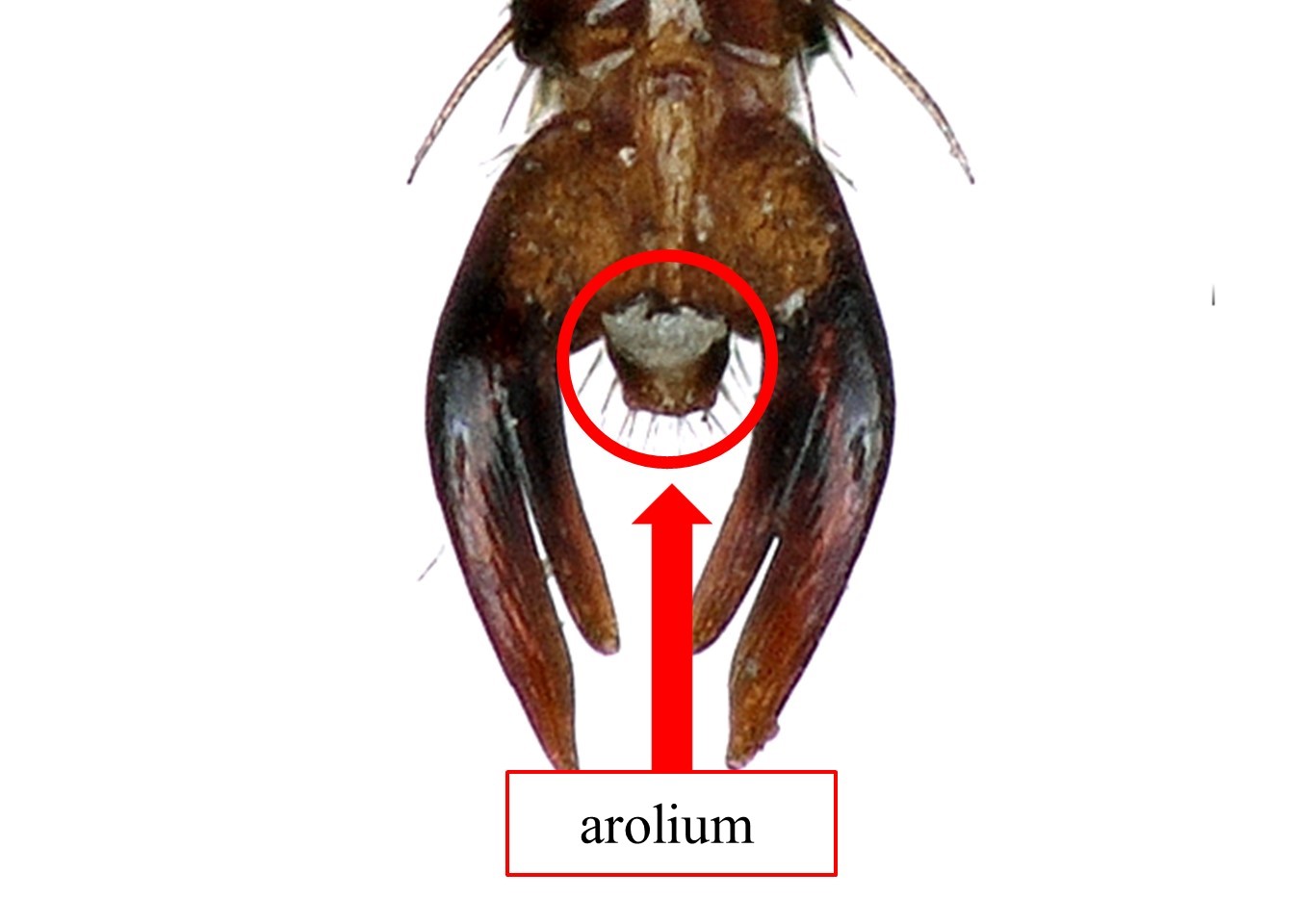Taxonomy
Family: Megachilidae
Subfamily: Megachilinae
Tribe: Anthidiini
Genus: Rhodanthidium Isensee, 1927
Subgenera: Asianthidium, Meganthidium, Rhodanthidium
Common name: snail-shell bees
Overview
Rhodanthidium are moderate to large sized bees, ranging from 11–22 mm in body length. They have black integumentintegument:
a tough, protective outer layer
with yellow or reddish-yellow maculations on their head, thorax, and abdomen (Michener 2007Michener 2007:
Michener, C.D. 2007. The Bees of the World (2nd ed.). Johns Hopkins University Press, Baltimore and London, 953 pp.).
Diversity
Rhodanthidium contains more than 13 species in three subgenera worldwide (Michener 2007Michener 2007:
Michener, C.D. 2007. The Bees of the World (2nd ed.). Johns Hopkins University Press, Baltimore and London, 953 pp.); none are known to occur in the U.S. or Canada.
Diagnostic characteristics
(modified from Michener 2007Michener 2007:
Michener, C.D. 2007. The Bees of the World (2nd ed.). Johns Hopkins University Press, Baltimore and London, 953 pp.)
- Arolia present.
- Juxtantennal carinacarina:
a clearly defined ridge or keel, not necessarily high or acute; usually appears on bees as simply a raised line
present.
- Labrum labrum:
part of the head abutting the clypeus, folds down in front of the mouthparts
 longer than clypeusclypeus:
longer than clypeusclypeus:
a section of the face below the antennae, demarcated by the epistomal sutures
 .
.
- Middle tibiatibia:
the segment of the leg, between the femur and the tarsus
 with one apicalapical:
with one apicalapical:
near or at the apex or end of any structure
spine.
- Omaular carinacarina:
a clearly defined ridge or keel, not necessarily high or acute; usually appears on bees as simply a raised line
absent.
- Pronotal lobe pronotal lobe:
a part of the pronotum located dorsally on the posterior margin of the pronotum and overlaps the anterior thoracic spiracle
 carinatecarinate:
carinatecarinate:
having keels or carinae
.
- Propodeum propodeum:
the last segment of the thorax
 without postspiricular foveafovea:
without postspiricular foveafovea:
a depressed region of cuticle; in bees this depressed area is usually only very slightly hollow and usually on the face.
present and defined by carinacarina:
a clearly defined ridge or keel, not necessarily high or acute; usually appears on bees as simply a raised line
.
- Stigma stigma:
a pigmented/ thickened spot on the costal margin of the forewing, usually at the end of the radius(Greek, stigma= mark)
 less than twice as long as broad.
less than twice as long as broad.
- Subantennal sutures straight.
- Female scopascopa:
modified hairs for carrying pollen; often branched and dense hairs on the hind-leg, or on the ventral surface of the abdomen in Megachilidae
present.
- Female S6S6:
the plates on the underside of the abdomen, often abbreviated when referring to a specific segment to S1, S2, S3, S4, S5, S6, S7, or S8
 without laterallateral:
without laterallateral:
relating, pertaining, or attached to the side
teeth.
- Male gonostyligonostyli:
the apical-most appendage of the male genitalia, which is usually quite hairy
have simple apices or two small teeth.
- Male T7T7:
the segments on the top side of the abdomen, often abbreviated when referring to a specific segment to T1, T2, T3, T4, T5, T6, or T7
 trifid (or with 5 projections in subgenus Meganthidium).
trifid (or with 5 projections in subgenus Meganthidium).
- Male S4S4:
the plates on the underside of the abdomen, often abbreviated when referring to a specific segment to S1, S2, S3, S4, S5, S6, S7, or S8
 and S5S5:
and S5S5:
the plates on the underside of the abdomen, often abbreviated when referring to a specific segment to S1, S2, S3, S4, S5, S6, S7, or S8
 of the sternasterna:
of the sternasterna:
the plates on the underside of the abdomen, often abbreviated when referring to a specific segment to S1, S2, S3, S4, S5, S6, S7, or S8
 often have median apicalapical:
often have median apicalapical:
near or at the apex or end of any structure
combs.
- Male S5S5:
the plates on the underside of the abdomen, often abbreviated when referring to a specific segment to S1, S2, S3, S4, S5, S6, S7, or S8
 with laterallateral:
with laterallateral:
relating, pertaining, or attached to the side
tooth.
May be confused with
Rhodanthidium may be confused with Pseudoanthidium (Neanthidium), due to both genera having yellow, broken medial bandsbands:
usually referring to bands of hair or bands of color that traverse across an abdominal segment
on their abdomens, but differ by the presence of aroliaarolia:
the cushion-like pad between the tarsal claws found at the ends of some bees' legs
 in Rhodanthidium (Michener 2007Michener 2007:
in Rhodanthidium (Michener 2007Michener 2007:
Michener, C.D. 2007. The Bees of the World (2nd ed.). Johns Hopkins University Press, Baltimore and London, 953 pp.). Benanthis also share many features with some species of Rhodanthidium. They differ in that the T7T7:
the segments on the top side of the abdomen, often abbreviated when referring to a specific segment to T1, T2, T3, T4, T5, T6, or T7
 of Rhodanthidium males have 3 or 5 teeth and Benanthis have a bilobed T7T7:
of Rhodanthidium males have 3 or 5 teeth and Benanthis have a bilobed T7T7:
the segments on the top side of the abdomen, often abbreviated when referring to a specific segment to T1, T2, T3, T4, T5, T6, or T7
 . Female Benanthis have laterallateral:
. Female Benanthis have laterallateral:
relating, pertaining, or attached to the side
teeth on S6S6:
the plates on the underside of the abdomen, often abbreviated when referring to a specific segment to S1, S2, S3, S4, S5, S6, S7, or S8
 , while Rhodanthidium lacks teeth on S6S6:
, while Rhodanthidium lacks teeth on S6S6:
the plates on the underside of the abdomen, often abbreviated when referring to a specific segment to S1, S2, S3, S4, S5, S6, S7, or S8
 .
.
Known invasives
There are no known invasives.
Host associations
Rhodanthidium visit plants within the families Asteraceae and Fabaceae (Proctor et al. 1996Proctor et al. 1996:
Proctor, M., P. Yeo, and A. Lack. 1996. The natural history of pollination. Timber Press, Portland.). Rhodanthidium siculum has been observed collecting pollen and nectar from flowers such as Galactites tomentosus, Centaurea sphaeocephala, Glebionis coronaria, and Lotus creticus (Erbar and Leins 2017Erbar and Leins 2017:
Erbar, C. and P. Leins. 2017. Sex and breeding behavior of the Sicilian snail-shell bee ( Rhodanthidium siculum Spinola, 1838; Apoidea-Megachilidae): preliminary results. Arthropod-Plant Interactions 11: 317ndash;328.).
Nesting behavior
Many species of
Rhodanthidium (e.g.,
R. siculum) nest in empty snail shells (
Peisl 1999Peisl 1999:
Peisl, P. 1999. Beobachtungen und Gedanken zum Verhalten von Bienen-Mannchen. Bembix 12: 21ndash;25.). Females deposit sand and saliva in the navel of the shell. They then provision the shells with pollen and nectar from host flowers. Females will copulate with multiple male partners, and then lay one or two eggs within the shell, which is then closed with pieces of seashell or snail shell, saliva, and sand. They will then transport the closed shell to a safe location where it is buried, often underneath plants (
Erbar and Leins 2017Erbar and Leins 2017:
Erbar, C. and P. Leins. 2017. Sex and breeding behavior of the Sicilian snail-shell bee ( Rhodanthidium siculum Spinola, 1838; Apoidea-Megachilidae): preliminary results. Arthropod-Plant Interactions 11: 317ndash;328.).
Distribution
Rhodanthidium are found from the Mediterranean area to southwestern and central Asia and central Europe (Michener 2007Michener 2007:
Michener, C.D. 2007. The Bees of the World (2nd ed.). Johns Hopkins University Press, Baltimore and London, 953 pp.).

Distribution map generated by Discover Life -- click on map for details, credits, and terms of use.
References
Erbar, C. and P. Leins. 2017. Sex and breeding behavior of the Sicilian snail-shell bee (
Rhodanthidium siculum Spinola, 1838; Apoidea-Megachilidae): preliminary results. Arthropod-Plant Interactions 11:317-328.
Michener, C.D. 2007. The Bees of the World. 2nd ed. Johns Hopkins University Press, Baltimore and London, 953 pp.
Peisl, P. 1999. Beobachtungen und Gedanken zum Verhalten von Bienen-Mannchen. Bembix 12:21-25.
Proctor, M., P. Yeo, and A. Lack. 1996. The natural history of pollination. Timber Press, Portland.
 longer than clypeusclypeus:
longer than clypeusclypeus: less than twice as long as broad.
less than twice as long as broad. without laterallateral:
without laterallateral: trifid (or with 5 projections in subgenus Meganthidium).
trifid (or with 5 projections in subgenus Meganthidium). and S5S5:
and S5S5: of the sternasterna:
of the sternasterna: often have median apicalapical:
often have median apicalapical: with laterallateral:
with laterallateral: in Rhodanthidium (Michener 2007Michener 2007:
in Rhodanthidium (Michener 2007Michener 2007: of Rhodanthidium males have 3 or 5 teeth and Benanthis have a bilobed T7T7:
of Rhodanthidium males have 3 or 5 teeth and Benanthis have a bilobed T7T7: . Female Benanthis have laterallateral:
. Female Benanthis have laterallateral: , while Rhodanthidium lacks teeth on S6S6:
, while Rhodanthidium lacks teeth on S6S6: .
.